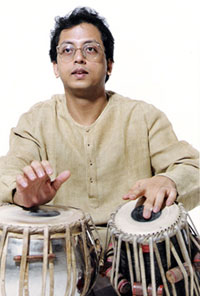Invitation
Program
Samraat Club
Pt. Hariprasad Chaurasia
Ustad Shujaat Husain Khan
Pt. Yogesh Samsi
Rupak Kulkarni
Marina Alam
Photos
Reviews
|
| International Festival of Indian Classical Music: September 20, 2006 |
| |
| PT. YOGESH SAMSI |
 PT. YOGESH SAMSI is one of those rare tabla players whose reputation has been built on his consummate artistry in both fields of accompaniment and solo playing. The son of the renowned vocalist Pandit Dinkar Kaikini, Yogesh Samsi was initiated into tabla by his father at the tender age of four, and later received guidance under Pandit H.Taranath Rao. However it was under the gifted tutelage of the legendary Ustad Alla Rakha that Yogesh received intense training for twenty three years and, matured into a fine young tabla player. PT. YOGESH SAMSI is one of those rare tabla players whose reputation has been built on his consummate artistry in both fields of accompaniment and solo playing. The son of the renowned vocalist Pandit Dinkar Kaikini, Yogesh Samsi was initiated into tabla by his father at the tender age of four, and later received guidance under Pandit H.Taranath Rao. However it was under the gifted tutelage of the legendary Ustad Alla Rakha that Yogesh received intense training for twenty three years and, matured into a fine young tabla player.
Yogesh has accompanied almost all the top ranking instrumentalists and vocalists and dancers of India, including Ustad Vilayat Khan, Pt Dinkar Kaikini, Pt Bhimsen Joshi, Pt Shivkumar Sharma, Pt Hariprasad Chaurasia, Ustad Amjad Ali Khan and Pt Birju Maharaj. Apart from accompaniment Yogesh has performed numerous memorable solo performances in India and abroad. He has also had the privilege of accompanying his teacher Ustad Alla Rakha and his son the great maestro Ustad Zakir Hussain in their solo performances.
Besides performing Yogesh has a sound scholastic approach to the subject and has taken several successful workshops in world music centres in India, U.S.A, U.K, South Africa and Japan. He is also a highly respected teacher, creating a syllabus for learning tabla designed specifically for teachers in the West, an initiative which is sure to have great benefits for the advancement of tabla worldwide. Yogesh has also worked on an instructional CD-Rom about tabla which is now available for students. With the growing influences of modern and fusion music, Yogesh Samsi strives to keep up his revered Guru's word of preserving the tradition in the presentation of tabla solo.
|
| |
TABLA:
The Tabla is the most popular and widely used drum of North India. Its colourful range of tonal qualities combined with its capacity to express remarkable rhythmic permutations make it a unique percussion instrument which in recent times has inspired and fascinated audiences worldwide. The pair of drums consist of a high-pitched, precisely tuned dahina (also called dayan or tabla), and a low-pitched, less precisely tuned drum, the bayan. The dahina is responsible for many of the resonant ringing sounds (or bols). The bayan provides the bass and is recognizable for its swooping bass sound, which provides colourful embellishment. The bayan is often said to be where the soul of the instrument lies.
Most frequently the tabla is used to accompany classical instrumental, vocal and dance performances, but as all tabla players will remind you there also exists a strong tradition of tabla solo playing. The history of tabla is shrouded in mystery and mythology; however it is most commonly thought to have developed in the area of Delhi in the mid eighteenth century. Initially, much of the inspiration for its repertoire was borrowed and adapted from other Indian drums including pakhawaj and dholak. However, over the period since then, tabla players have built up a huge repertoire of material specific to the dynamics of the tabla. This vast range of compositions has been made richer by the evolution of a number of distinct regional performance styles, known as gharanas, of which there are six recognised by the tabla community, namely, Delhi, Ajrara, Farukhabad, Lucknow, Benares and Punjab. These styles have played a major role in the development of tabla playing with regard to technique and repertoire.
The tabla player uses a vocabulary of semi-onomatopoeic syllables to represent the strokes on the instrument known as 'bols' (from the Hindi verb bolna, 'to speak'), a system which has been used to orally communicate compositions through the ages. Bols making up popular phrases such as 'dhati dhage tina gina' and 'dhati dhatere ketetake terekete', are recited by the player before playing, in a practice known as Pardhant, a kind of Indian version of rap. While in training a student is typically taught to speak the bols of the composition before actually playing it on the drums.
|
|
| |
|

